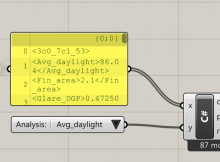Another example on how to automatically create a value list in Grasshopper using the C# component.
This file is mostly for personal reference, but there are snippets in here that you may find useful. I designed this component to read a text file containing XML-like data, save the data in a class structure, and then filter the data. The filtering is done by a drop-down list that is automatically added by the component, and is pre-populated with valid options.
Useful code includes:
- How to create a value list with C# code
- How to populate the value list
- How to create and use a DataTree in the C# component
C# code
This code is designed for the C# component in Grasshopper.
private void RunScript(List<string> x, int y, ref object params_, ref object results_) { var models = new List<Model>(); //parse input text for (int i = 0; i < x.Count; i += (valuecount + 2)) { var model = new Model(); model.Params = FormatParamString(x[i]); //convert CSV to list of doubles for (int j = i + 1; j < i + 4; j++) { var item = new DictItem(); FormatModelLine(x[j], out item.Name, out item.Value); model.Results.Add(item); } models.Add(model); } Component.Message = models.Count.ToString() + " models"; AnalysisTypes = CalcUniqueAnalyses(models); //make dropdown box if(Component.Params.Input[1].SourceCount == 0 && Component.Params.Input[0].SourceCount > 0) { var vallist = new Grasshopper.Kernel.Special.GH_ValueList(); vallist.CreateAttributes(); vallist.Name = "Analysis types"; vallist.NickName = "Analysis:"; vallist.ListMode = Grasshopper.Kernel.Special.GH_ValueListMode.DropDown; int inputcount = this.Component.Params.Input[1].SourceCount; vallist.Attributes.Pivot = new PointF((float) this.Component.Attributes.DocObject.Attributes.Bounds.Left - vallist.Attributes.Bounds.Width - 30, (float) this.Component.Params.Input[1].Attributes.Bounds.Y + inputcount * 30); vallist.ListItems.Clear(); for(int i = 0; i < AnalysisTypes.Count; i++) { vallist.ListItems.Add(new Grasshopper.Kernel.Special.GH_ValueListItem(AnalysisTypes[i], i.ToString())); } vallist.Description = AnalysisTypes.Count.ToString() + " analyses were found in the SBA file."; GrasshopperDocument.AddObject(vallist, false); this.Component.Params.Input[1].AddSource(vallist); vallist.ExpireSolution(true); } //we now have our results in a nice classy format. let's convert them to a datatree var resultsvals = new DataTree<double>(); var paramvals = new DataTree<double>(); string astr = AnalysisTypes[y]; Component.Params.Output[1].VolatileData.Clear(); //bug fix for when new dropdown is made Component.Params.Output[2].VolatileData.Clear(); //bug fix for when new dropdown is made for (int i = 0; i < models.Count; i++) { var pth = new GH_Path(i); foreach (var result in models[i].Results) { if(astr == result.Name) { resultsvals.Add(result.Value, pth); foreach(var param in models[i].Params) { paramvals.Add(param, pth); } } } } results_ = resultsvals; params_ = paramvals; } // <Custom additional code> int valuecount = 3; List<string> AnalysisTypes = new List<string>(); public class DictItem { public DictItem() { } public string Name; public double Value; } public class Model { public Model() { } public List<double> Params = new List<double>(); public List<DictItem> Results = new List<DictItem>(); public List<string> ToListString() { var rtnlist = new List<string>(); foreach (var result in Results) rtnlist.Add(result.Name + ", " + result.Value.ToString()); return rtnlist; } } List<double> FormatParamString(string input) { var rtnlist = new List<double>(); input = input.Replace("<", ""); input = input.Replace(">", ""); input = input.Replace('m', '-'); input = input.Replace('_', '.'); string[] splitstring = input.Split('c'); foreach(string str in splitstring) { try { rtnlist.Add(Convert.ToDouble(str)); } catch { rtnlist.Add(0); } } return rtnlist; } /// <summary> /// Get name and value of analysis from an SBA string /// </summary> /// <param name="input"></param> /// <param name="name"></param> /// <param name="val"></param> /// <returns></returns> void FormatModelLine(string input, out string name, out double val) { int firstopen = input.IndexOf('<'); int firstclose = input.IndexOf('>'); int lastopen = input.LastIndexOf('<'); name = input.Substring(firstopen + 1, firstclose - firstopen - 1); val = Convert.ToDouble(input.Substring(firstclose + 1, lastopen - firstclose - 1)); } /// <summary> /// Get analysis types from list of models /// </summary> /// <param name="models"></param> /// <returns></returns> List<string> CalcUniqueAnalyses(List<Model> models) { List<string> rtnlist = new List<string>(); foreach (var model in models) { foreach (var result in model.Results) { bool found = false; foreach (var calc in rtnlist) { if(calc == result.Name) found = true; } if(!found) rtnlist.Add(result.Name); } } return rtnlist; }
